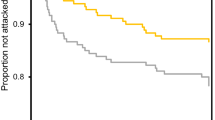Abstract
MANY distasteful species are conspicuously coloured1 and this is believed to aid their survival through the formation of ‘avoidance images’2 by predators. It has been suggested that ‘an efficient escape mechanism’ either provided by a jumping response3,4, or a fast escape flight5–7, could be as powerful as distastefulness in influencing a predator's strategy of prey selection, or could in some instances help to increase the relative frequency of an agile mimic of a distasteful but sluggish model8. Lindroth3 has made observations on several genera of flea-beetles (Alticinae, Chrysomelidae) and has found great external similarities between them and ground beetles of the genus Lebia (Carabidae), the larva of which is an ectoparasite of the flea-beetle's pupa. He suggests that the flea-beetle, which can escape suddenly from its exposed position on the food-plant by jumping, acts as a model and Lebia as a relatively sluggish mimic. As a parasite, Lebia is found in fewer numbers than the host, a situation also expected of some mimics in relation to their models. Neither was found to be distasteful to bird predators3. Thompson4 makes use of Lindroth's3 hypothesis in explaining the occurrence of an apparently aposematic form in females of the nonmimetic common meadow spittlebug, Philaenus spumarius, which is acceptable to predators but for the possession of an efficient close-quarter escape mechanism. Thompson proposes that this mechanism accounts for aposematic morph P. spumarius marginella occurring at a frequency in the population above that maintainable through apostatic selection. In both cases it is proposed that a learning predator comes to associate a particular colour pattern with wasted effort and spurns all forms with a similar appearance.
Similar content being viewed by others
References
Cott, H. B., Adaptive Coloration in Animals, 256–258 (Methuen, London, 1940).
Clarke, B., Systematics Association Publications No. 4 Taxonomy & Geography, 47–70 (1962).
Lindroth, C. H., Ent. Scand., 2, 41–48 (1972).
Thompson, V., Nature, 242, 126–128 (1973).
Jones, F. M., Trans. R. ent. Soc. Lond., 79, 345–385 (1932).
Sommeron, V. G. L., and Jackson, T. H. E., J. Lepit. Soc., 13, 121–150 (1960).
Hespenheide, H. A., J. Ent. Ser. A., 43, 49–55 (1973).
Rothschild, The Hon. M., in Ecological Genetics & Evolution (Edit. by Creed, R.) 202–223 (Blackwell, Oxford, 1971).
Pumphrey, R. J., Ibis, 90, 171–190 (1948).
Klopfer, P. M., in Behavioural Aspects of Ecology, 10–34 (Prentice-Hall, New Jersey, 1962).
Siegel, S., in Non-parametric Statistics for the Biological Sciences, 184–193 (McGraw-Hill, 1956).
Reiskind, J., Anim. Behav., 13, 466–469 (1965).
Sutherland, N. S., and Mackintosh, N. J., in Mechanisms of Animal Discrimination Learning, 338–403 (Academic Press, 1971).
Tinbergen, L., Archs neerl. Zool., 13, 265–336 (1960).
Author information
Authors and Affiliations
Additional information
The original article can be found online at https://doi.org/10.1038/250452b0
Rights and permissions
About this article
Cite this article
GIBSON, D. Batesian mimicry without distastefulness?. Nature 250, 77–79 (1974). https://doi.org/10.1038/250077a0
Received:
Revised:
Published:
Issue Date:
DOI: https://doi.org/10.1038/250077a0
- Springer Nature Limited
This article is cited by
-
Catching the red eye: field evidence that artificial prey with red eye-like markings are preferentially avoided by avian predators
Evolutionary Ecology (2023)
-
Philaenus spumarius: when an old acquaintance becomes a new threat to European agriculture
Journal of Pest Science (2018)
-
Both Palatable and Unpalatable Butterflies Use Bright Colors to Signal Difficulty of Capture to Predators
Neotropical Entomology (2016)
-
Some Possible Cases of Escape Mimicry in Neotropical Butterflies
Neotropical Entomology (2014)
-
Chemical defence in ladybird beetles (Coccinellidae). I. Distribution of coccinelline and individual variation in defence in 7-spot ladybirds (Coccinella septempunctata)
CHEMOECOLOGY (1991)





